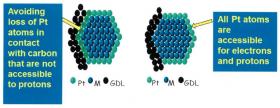Technologies Available for License
Categories: advanced materialsenergy
2013-025: Core-Shell Fuel Cell Electrodes
Invention: 2013-025
Patent Status: U.S. Patent Number 9,716,279 was issued on July 25, 2017
For technical and licensing related questions, email tcp@bnl.gov.
Summary

Artist's rendition of the arrangement of platinum atoms in common use (left) and in the inventive scheme (right).
Platinum is the best catalyst for the oxygen reduction reaction, the limiting reaction in fuel cells. It is also one of the least abundant and most expensive metals. For the best utilization of platinum, monolayers of the noble metal are deposited on a less expensive particle core. These core-shell particles are then incorporated as catalysts, often on a gas diffusion layer or other support. To improve the utilization of platinum even further, the inventors have developed a method of depositing the platinum monolayers on the particle cores after the cores have been attached to the support. In this way there are no inactive noble metal atoms trapped between the cores and the support.
Description
An electrocatalyst with gas-diffusion layer in contact directly with one side of the particle cores. The side of the particle cores that is not in contact with the gas-diffusion layer has a thin layer of catalytically active metal atoms adhered to it. The active metal atoms can be one of one of ruthenium, rhodium, palladium, silver, rhenium, osmium, iridium, platinum, and gold.
Benefits
Polymer electrolyte membrane fuel cells (PEMFCs) require platinum (Pt) catalyst as an active material of electrodes. This method increases the reaction sites in the catalytic layer and therefore improves electrode performance and reduce Pt loading.
Applications and Industries
Fuel Cell Catalyst
Journal Publication & Intellectual Property
- US 9,716,279 B2 (.pdf)
- US 9,853,255 B2 (.pdf)
Tags: electrocatalystelectrode
Contacts
-

Poornima Upadhya
Manager Technology Transfer & Commercialization
Technology Commercialization
(631) 344-4711, pupadhya@bnl.gov
-

Avijit Sen
IP Licensing & Commercialization
Technology Commercialization
(631) 344-3752, asen@bnl.gov
-





